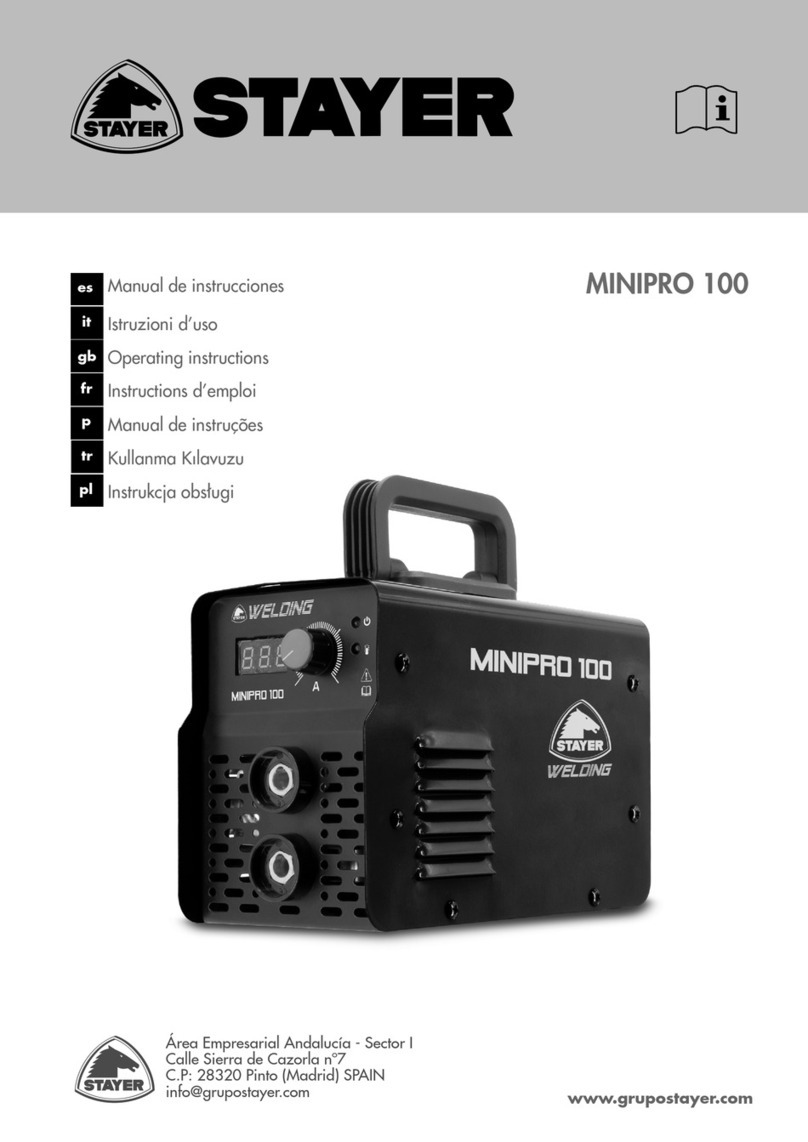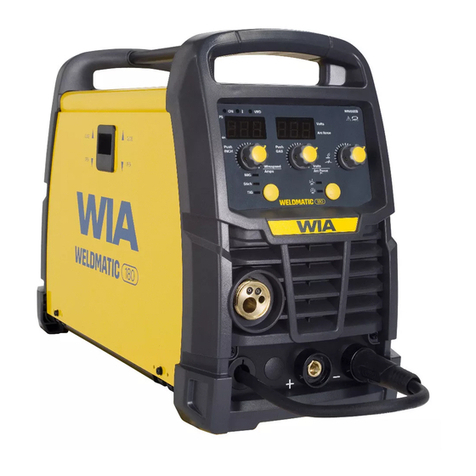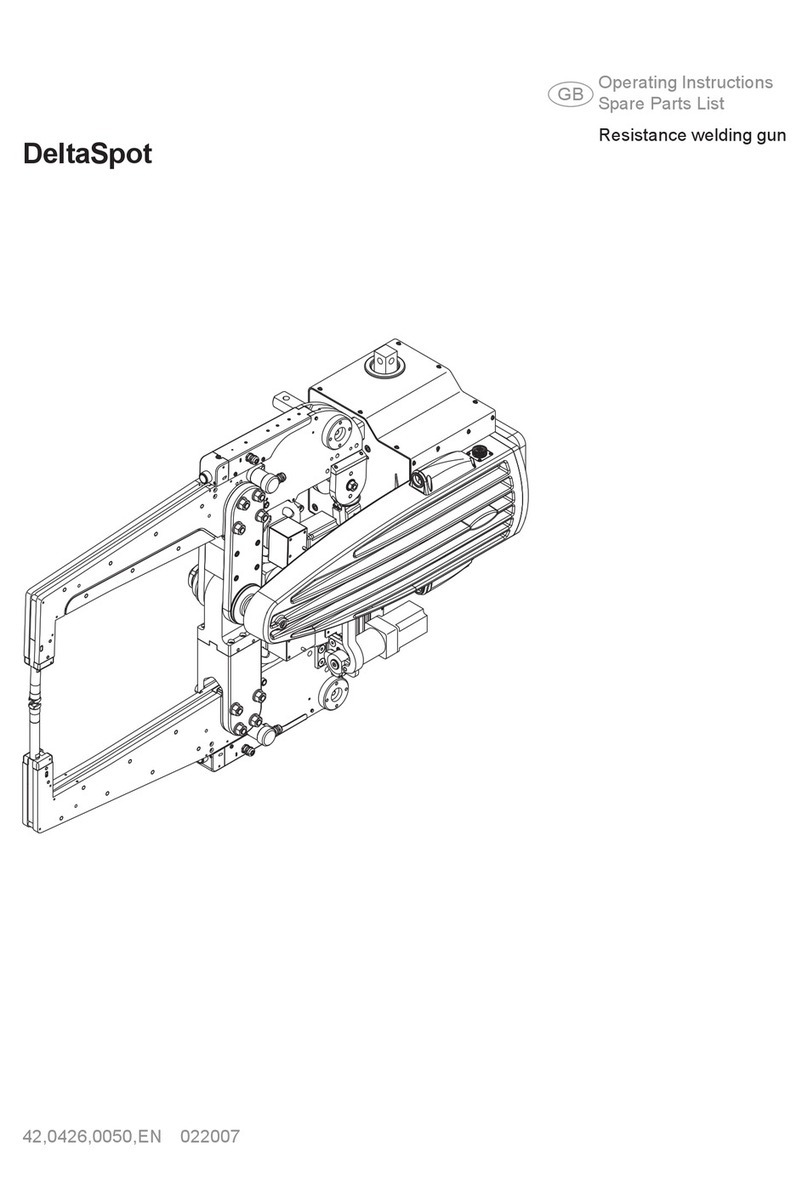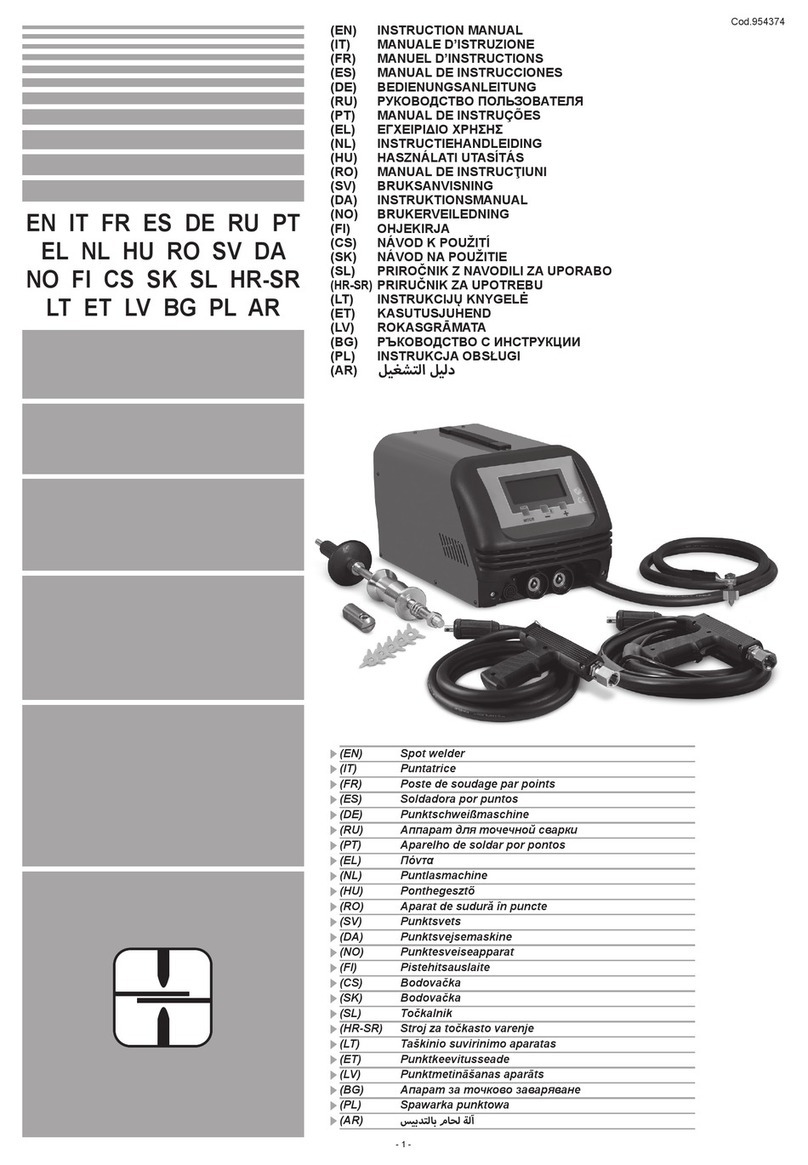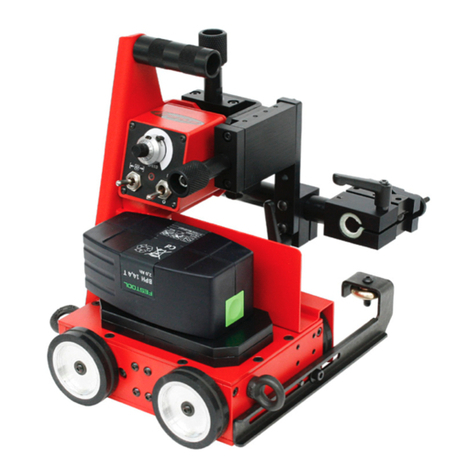SimTech WeldTech User manual

www.SimtechUSA.com
WeldTech
Hot Air Welder
Operation Manual
Corrosion Resistant Fluid and
Air Handling Systems.

SIMTECH
Phone: 877-777-2467 • Fax: 215-547-9129
www.SimtechUSA.com
2
WeldTech - Hot Air Welder Instruction Manual
1.092909
WARNING
Danger to life when opening the tool as live components and connections are
exposed. Unplug the tool before opening it.
Incorrect use of hot-air blowers can cause fire and explosion hazard, especially
near combustible materials and explosive gases.
Do not touch heater tube and nozzle when they are hot. They may cause burns. Let
the tool cool down. Do not point hot air flow in the direction of people or animals.
CAUTION
The voltage rating stated on the tool must correspond to the line/mains voltage.
For personal protection on building sites we strongly recommend the tool be
connected to a GFCI (Ground Fault Circuit interrupter) or a RCCB (Residual Current
Circuit Breaker).
The tool must be operated with supervision. Heat can reach combustible materials,
which are out of sight.
Store the tool Indoors when not in use
Protect tool from getting wet.
I
I
I
I
I
I
TECHNICAL DATA
Voltage
Power Consumption
Temperature
Air Flow
Air Pressure
Noise Emission Level
Weight
Size
V~
W
°C
I/MIN
PA
LPA (db)
kg
mm
42 100 120 200 230 50/60 Hz
1000 1400 1600 1400 16000
200-700, Infinitely Controlled
Max 300
ca 3000 (30mbar) after about 24 hours operation Time
65
1.3 With 3m cor
Ø 100mm x 330mm Handle Ø 56mm

SIMTECH
Phone: 877-777-2467 • Fax: 215-547-9219
www.SimtechUSA.com
3
WeldTech - Hot Air Welder Instruction Manual
1.092909
APPLICATION
• Welding of thermoplastic materials as well as single-ply flexible plastics and modified bitumen
in the form of boards, tubes, profiles, lining membranes, coated materials, films, foams, tiles,
and sheets. The following procedures are possible: overlap welding, welding with rod, with
tape, butt welding and melt welding
• Heating-up for forming, bending and sealing of thermoplastic semi-finished materials and
plastic granules
• Drying of water-damp surfaces
• Shrinking of heat-shrink sleeves, films, tapes, solder sleeves, pre formed and moulded parts
• Soldering of copper pipes, solder joints and metal foils
• Defrosting of frozen water pipes
• Activating/dissolving of solvent free adhesives and fusion adhesives
• Igniting of wood shavings, paper, coal or straw in furnaces
APPROVAL MARKS
This Tool Is CCA Certified ( CENELEC Certification Agreement)

SIMTECH
Phone: 877-777-2467 • Fax: 215-547-9129
www.SimtechUSA.com
4
WeldTech - Hot Air Welder Instruction Manual
1.092909
Readiness for working
• Fit appropriate nozzle as required.
• Connect tool to the line/mains.
• Adjust hot air temperature:
PP set to 4-5 with the potentiometer (3).
PVDF set to 7 with the potentiometer (3).
• Switch on main switch (2) and heat up the tool for approximately 5 minutes
Operation
• Carry out a test weld in accordance with the material manufacturer’s welding instructions and
national guidelines or regulations.
• Check the test weld
• Set welding temperature (welding parameter) as required.
• Cool down the tool after use.
• For more details reference instructions section (Page 6)
Change of nozzles
• Before changing nozzles cool down the tool or use only pliers/wrench.
• Do not touch hot nozzle (9) and make sure to place it on a heat resistant surface, because of
fire hazard,
• Push the nozzle (9) on the heater tube (7) and secure the nozzle by the screw on the clamp
(10)
• Screw the nozzle (9) and secure by wrench.
• Use, SIMTECH nozzles only.
1 - Power supply cord
2 - Main switch
3 - Potentiometer for temperature adjustment
4 - Handle
5 - Air filter
6 - Rubber stand
7 - Heater tube
8 - Heat protection tube
9 - Nozzle (not included)
10 - Screw on the clamp
11 - Temperature scale

SIMTECH
Phone: 877-777-2467 • Fax: 215-547-9219
www.SimtechUSA.com
5
WeldTech - Hot Air Welder Instruction Manual
1.092909
ACCESSORIES
• Use SIMTECH accessories only
MAINTENANCE
• Clean polluted air filter (5) with a small brush or replace it,
• Clean welding nozzle with brush.
• Check mains cable (1) and plug for electrical and mechanical damage.
SERVICE AND REPAIRS
• The motor switches off automatically when the brushes reach their minimum length. Have the
tool checked by your Service Centre The life of the brushes is about 1600 running hours of the
welding tool’s motor,
• Repairs should be carried out by authorised SIMTECH Service Centres only. They guarantee
a specialised and reliable Repair Service within 24 hours using original spare parts according
to schematics and spare parts lists,
GUARANTEE AND LIABILITY
• Guarantee and liability are in accordance with the guarantee certificate as well as with the
currently valid general business and sales conditions
• SIMTECH rejects any guarantee claims for tools which are not in their original condition. The
tool must never be altered or changed.
Technical data and specifications are subject to change without prior notice.
Heater tube with heat
protection tube for SIMTECH
push-fit nozzles
Heater tube with heat
protection tube for SIMTECH
Screw-on Nozzles
VERSIONS

SIMTECH
Phone: 877-777-2467 • Fax: 215-547-9129
www.SimtechUSA.com
6
WeldTech - Hot Air Welder Instruction Manual
1.092909
1 COMMON THERMOPLASTICS AND WELDING TECHNIQUES
The most commonly weld thermoplastic materials are PVC, PP, PE, PVDF and CPVC. Other
materials such as ABS, PS, PC and PMMA have limited weldability and do not warrant any further
discussion.
The most common methods of welding include hot air (gas) welding, extrusion, butt fusion
(heated element welding), friction welding and high frequency welding. In the following, hot
air (gas) welding is being addressed since it plays a major role in the fabrication of low quantity
structures and equipment.
2 HOT AIR WELDERS
2.1 THE PROCESS IN GENERAL
In order to weld thermoplastics, the material has to be heated to reach its plasticized state. The
pieces to be welded must then be pressed together with a certain amount of pressure over a
given amount of time. This will cause the surface molecules of the welded parts to interlock,
provided resin compatibility is present. In hot air (gas) welding, the heat transfer medium is a
heated gas, either Nitrogen or clean air. In the infancy of plastic welding, the use of Nitrogen
proved most successful for prevention of material contamination and oxidation. With today’s
material quality and equipment technology, Nitrogen is becoming more and more a relic of the
past. The combination of clean, oil and moisture free air with controlled temperature proves
equally successful, eliminating the continuous expense of the inert gas. The temperature of the
hot air ranges between 250°C (480°F) and 450°C (850°F) depending on the type of material
(different melting points), material mass to be risen in temperature (usually the material thickness)
and the conditions under which the welding process takes place (indoors or outdoors, ambient
temperature, and so on).
2.2 THE HOT AIR GENERATING EQUIPMENT
The air flows through a hand welding gun where it is heated up by an electrical heating element.
Two principles are used to control the air temperature. The older principle uses a constant
wattage heating element and varies the amount of air flow in order to increase or decrease the
air temperature. The drawback to this method is that a wider area than necessary is heated up.
This introduces heat stress related problems into the material that may cause cracks based on the
material expansion and contraction factors.
The newer method of controlling hot air temperature involves the use of electronic circuitry to
control the actual applied wattage of the heating element using a constant, minimal air flow. This
way the area heated up on the plastic material can be kept to a minimum. The second advantage
of electronic controls is a safety feature preventing burn out of the element or melt down of the
gun in case of air flow interruption.

SIMTECH
Phone: 877-777-2467 • Fax: 215-547-9219
www.SimtechUSA.com
7
WeldTech - Hot Air Welder Instruction Manual
1.092909
The latest trend in developing electronic
controls for hot air heating elements
incorporates closed loop controls that hold
the temperature constant even while air flow
or supply voltage fluctuate.
An equally important factor in hot air
welding is the style and type of welding
nozzle (tip). Their function is to properly
distribute the hot air onto the parent sheet
and to heat up and guide the welding rod in
the high speed welding process. A variety of
tips are available for specific applications.
In the field of plastics fabrication, the most
common nozzles are the round (freehand),
tacking high speed and the combination high
speed welding and tacking tips.
2.3 MATERIAL PREPARATION
A good homogeneous weld requires proper preparation of the material. The part should be free
of any impurities such as dirt, oil, etc. Additionally, some thermoplastics develop a thin layer
of oxidized molecules on the surface that have to be scraped or ground off. Another effect,
especially with HDPE, is the migration of unchained, lower density molecules to the surface
caused by internal pressure of the material. This gives the usually “waxy” surface appearance of
PE. Grinding or scraping the weld area is therefore strongly recommended. Any dust should be
wiped off with a clean cloth.
2.4 TACK WELDING
The initial step in the welding process is the “Tack weld.” The objective is to put the parts into
place, align or realign them and to prevent slippage of the material during the structural welding
process (high speed weld, extrusion weld, etc.). Common sense should determine whether an
intermittent or continuous tack weld is applied. Larger structures and thick gauge materials may
even require additional clamping. All tanks should be properly tack welded to achieve a leak free
connection. This avoids solutions from penetrating between the tank wall and bottom in case of a
problem with the filler weld.

SIMTECH
Phone: 877-777-2467 • Fax: 215-547-9129
www.SimtechUSA.com
8
WeldTech - Hot Air Welder Instruction Manual
1.092909
2.5 HIGH SPEED WELDING
As far as hand welding is concerned, more than 90% of the structural welds are high speed
welded. In this process a filler material, the welding rod, is introduced into the seam to give
supportive strength. Standard rod profiles are round and triangular. Triangular rod is applied
where cosmetic appearance is important, e.g., furniture, laboratory equipment, etc. It can only be
used as a single supportive weld and does not allow for the kind of surface penetration that can
be achieved with round welding rod.
Round welding rod is used where “heavy duty” welds are required. It allows the fabricator to lay
several beads of welding rod on top of each other. This way, a relatively thin welding rod can be
used to produce a strong weld even on heavy gauge material. Common rod diameters are 1/8,
5/32, 3/16, 1/4” and their metric equivalents 3, 4, 5, 6mm.
The design of the high speed welding nozzle needs to satisfy 3 conditions: pre-heating the base
material, guiding and pre-heating the welding rod and allowing for the application of pressure on
both the rod and substrate.
It is important to select the correct diameter tip for the selected
welding rod. An oversized nozzle will negatively affect the
guidance and applied pressure and may also cut into the welded
sheet.
For quick trouble-free change over from tacking to high speed
welding, a combination nozzle with both features prevents worn
tip threads and burnt fingers.
12
3
4
5
6
7
8
1. Welding Bead
2. Wash
3. Welding Direction
4. Hot Air
5. Air Heater
6. Welding Rod
7. Welding Rod at Plasticized State
8. Pressure

SIMTECH
Phone: 877-777-2467 • Fax: 215-547-9219
www.SimtechUSA.com
9
WeldTech - Hot Air Welder Instruction Manual
1.092909
3. BEAD FORMS
There are a great number of bead forms that can be specified; most common ones are shown on
the following page. Certain aspects must be taken into consideration before starting to weld. A
smaller diameter welding rod is preferable to a large one since it is easier and faster to control
the plasticizing process. The disadvantage is that multiple beads are required for thicker gauged
sheet. This could cause excessive heat stress due to the alternating heating and cooling cycles.
Therefore, it is sometimes advisable to choose a different method of welding, e.g., extrusion or
butt welding. Heat stress should also be taken into consideration when bead forms are selected.
For example, a butt joint performed with a double V design will generate less stress than a single
V design. Here both sides of the base material are heated up an even amount of times that
equalizes the expansion and contraction cycles.
Another consideration is the human factor. Hot air welding depends heavily upon the skill of the
operator, and sufficient margins should be designed into the finished product, A little extra time
spent on proper design and fabrication will help you to avoid the headaches caused by improper
design and hastily performed welds.
4. HEAT STRESS PROBLEMS
We will discuss heat stress in a little more detail in this section. Physical law dictates that
when materials are heated they expand, and they contract when cooled. This is known as the
coefficient of linear thermal expansion. Compared to metals, commercially used thermoplastics
have a much higher expansion factor under identical temperature conditions.
During hot air welding, the material will expand while it is
forced into a given position by the welding rod. When cooling
down, it will shrink back to its original volume but since it is
fixed , it will not shrink to its original shape. A sheet that was
straight may now be bowed. Due to their flexibility, thin gauge
materials may be bent back into their original shape Thicker
gauge materials create more difficulties. An experienced
operator will “pre-bend” the pads prior to the welding operation.
An additional factor to take into consideration is the eventual
service operating temperature of the finished product. A prime
example of this phenomenon experienced by many fabricators
is a PP tank with steel reinforcement. At a high operating
temperature, the tank walls will expand considerably. If the steel
bracing was fit too tightly around the tank, the tank will crack. To avoid this, service temperatures
must be taken into consideration during the design to allow for adequate tolerances.
Sheet Warpage caused by shrinkage
during the colling process
“Pre-Bending” prior to welding
After welding, the sheet pulls
itself straight

SIMTECH
Phone: 877-777-2467 • Fax: 215-547-9129
www.SimtechUSA.com
10
WeldTech - Hot Air Welder Instruction Manual
1.092909
24.03.2005Page 18
Hot Air Welding
Welding Parameters (according to DVS 2207 part 3)
Material Welding
procedures Welding force F
(N) 3mm Welding force F
(N) 4mm Hot air temp.
(°C)
15 – 20
25 – 35 300 – 320
305 – 315
330 – 350
340 – 360
300 – 370
320 – 370
365 – 385
15 – 20
25 – 35
8 – 12
15 – 25
15 – 20
20 – 25
18 – 25
7 – 12
PMMA PW
DW 12 – 16
12 – 16 12 – 16
20 – 30 40 – 60
15 – 20
25 – 35
Airflow
l / min
PE-HD PW
DW 6 – 10
10 – 16 40 – 50
PP PW
DW 6 – 10
10 – 16 40 – 50
PVC-U PW
DW 5 – 9
8 – 12 40 – 50
PVC-C PW
DW 10 – 15
15 – 20 40 – 50
PVC-P PW
DW 15 – 20
4 – 8 40 – 50
PVDF PW
DW 10 – 15
12 – 17 45 – 55
PW = Pendulum Welding
DW = Draw Welding The hot air temperature is measured in the hot air
stream, approx. 5mm in the middle of the nozzle.
5. WELDING PARAMETERS

SIMTECH
Phone: 877-777-2467 • Fax: 215-547-9219
www.SimtechUSA.com
11
WeldTech - Hot Air Welder Instruction Manual
1.092909
5.1 Welding Seam Preparation
Welding area and welding rod:
• Dry, clean, free of oil and grease
• Free of splints
• Free of notches
• Free of oxidation
(Joining area has to be scraped off right before the welding process)
Air pressure:
•The use of air pressure requires the installation of pressure
5.2 Evaluation of the Welding Seams
Hot Air Welding
Welding Seam Shapes
V-Seam
Fillet weld
Angle Joints
X-Seam (double-V-seam)
X-seam for thickness of 5mm and more

SIMTECH
Phone: 877-777-2467 • Fax: 215-547-9129
www.SimtechUSA.com
12
WeldTech - Hot Air Welder Instruction Manual
1.092909
5.3 Evaluation of the Welding Seams
Correctly Welded Seams:
• Slight flattening of the welding rod
• No notches between the welding layers
• Flat seam raise
• In particular for PVC:
- Foamy to smooth bead
- No discolouring (e.g. brownish colour)
• In particular for PE, PP, PVDF:
- Smooth double bead on both sides
- Dull surface in the area of the welding zone
5.4 Evaluation of the Welding Seams
Flawed welding seams:
• No building of bead or welding rod hardly flattened
- Temperature too low or
- Speed too fast or
- Welding force too small
• Notches between the welding layers
- Distance between the layers too big
5.5 Evaluation of the Welding Seams
Flawed welding seams:
• In particular for PVC:
- Brownish discoloring of the welding bead
- Temperature too high or speed too slow
• In particular for PE, PP, PVDF:
- Shiny welding zone
- Temperature too high or speed too slow

SIMTECH
Phone: 877-777-2467 • Fax: 215-547-9219
www.SimtechUSA.com
13
WeldTech - Hot Air Welder Instruction Manual
1.092909
NOTES

SIMTECH
Phone: 877-777-2467 • Fax: 215-547-9129
www.SimtechUSA.com
14
WeldTech - Hot Air Welder Instruction Manual
1.092909
NOTES

SIMTECH
Phone: 877-777-2467 • Fax: 215-547-9219
www.SimtechUSA.com
15
WeldTech - Hot Air Welder Instruction Manual
1.092909
NOTES

SIMTECH
Phone: 877-777-2467 • Fax: 215-547-9129
www.SimtechUSA.com
16
WeldTech - Hot Air Welder Instruction Manual
1.092909
Simtech Industrial Products, Inc.
47-A Runway Road, Levittown, PA 19057
Phone: 215-547-0444 Fax: 215-547-9129
Web site: www.SimtechUSA.com
WARRANTY
Simtech Industrial Products, Inc. products are warranted to be free from defects in materials and workmanship for one (1) year from date of
shipment. No claim shall be permitted under this warranty unless Buyer gives Simtech Industrial Products, Inc. written notice of all respects in
which Buyer claims the product to be defective. Notice must be received within ten (10) days from the date which the Buyer discovers, or should
have discovered the defect. Buyer shall give Simtech Industrial Products, Inc. a reasonable opportunity to inspect the product after notice has been
given. This warranty shall not apply to any products or components, which have been subjected to abnormal use, negligence or accident.
Seller’s sole obligation under this warranty shall be limited solely on the repair or replacement, as elected by Simtech Industrial Products, Inc., of
defective or nonconforming material. To the maximum extent permitted by law, Buyer irrevocably waives all claims for money damages relating
to the condition, use and performance of the goods purchased. In no event shall Simtech Industrial Products, Inc. liability exceed the purchase
price of the product sold by Simtech Industrial Products, Inc.
In no event, whether because of a breach of warranty or representation or any other cause, whether based upon contract, tort, warranty or
otherwise, arising out of the performance or nonperformance by seller of its obligations under this agreement or with respect to the products sold
pursuant here to; shall seller be liable for lost earnings, income or profits or indirect, incidental, liquidated or consequential damages.
The implied warranties of merchantability and fitness for a particular purpose except as set forth in this warranty, express or implied, are hereby
disclaimed and excluded. Nothing shall be construed as an additional warranty unless specifically designated as such in writing and signed by
Simtech Industrial Products, Inc.
Simtech Industrial Products, Inc. reserves the right, in its discretion, at any time and from time to time, to make changes to any specification, data
or information contained herein.
Other manuals for WeldTech
1
Table of contents
Popular Welding System manuals by other brands

Abicor Binzel
Abicor Binzel ABI-CAR E-1200 Operating instruction

Lincoln Electric
Lincoln Electric Power MIG 360MP Operator's manual

Lincoln Electric
Lincoln Electric AC-225C Specification sheet
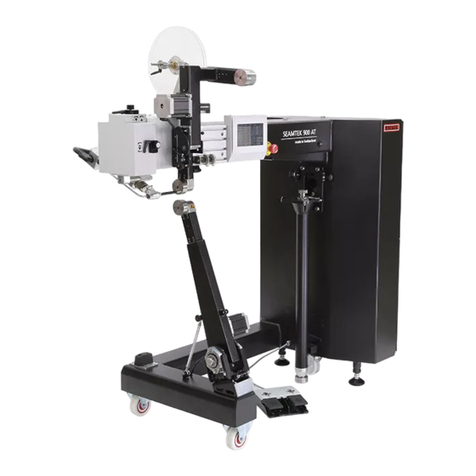
Leister
Leister SEAMTEK 900 AT operating instructions
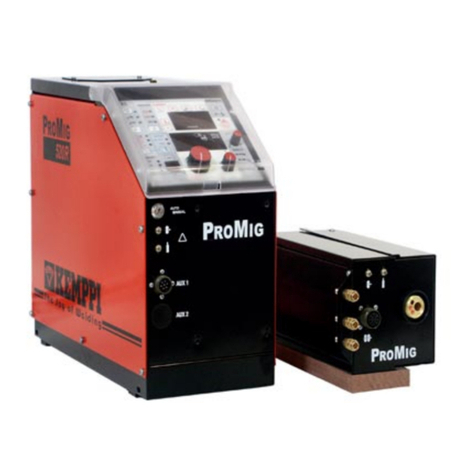
Kemppi
Kemppi Promig 520R Operation instructions
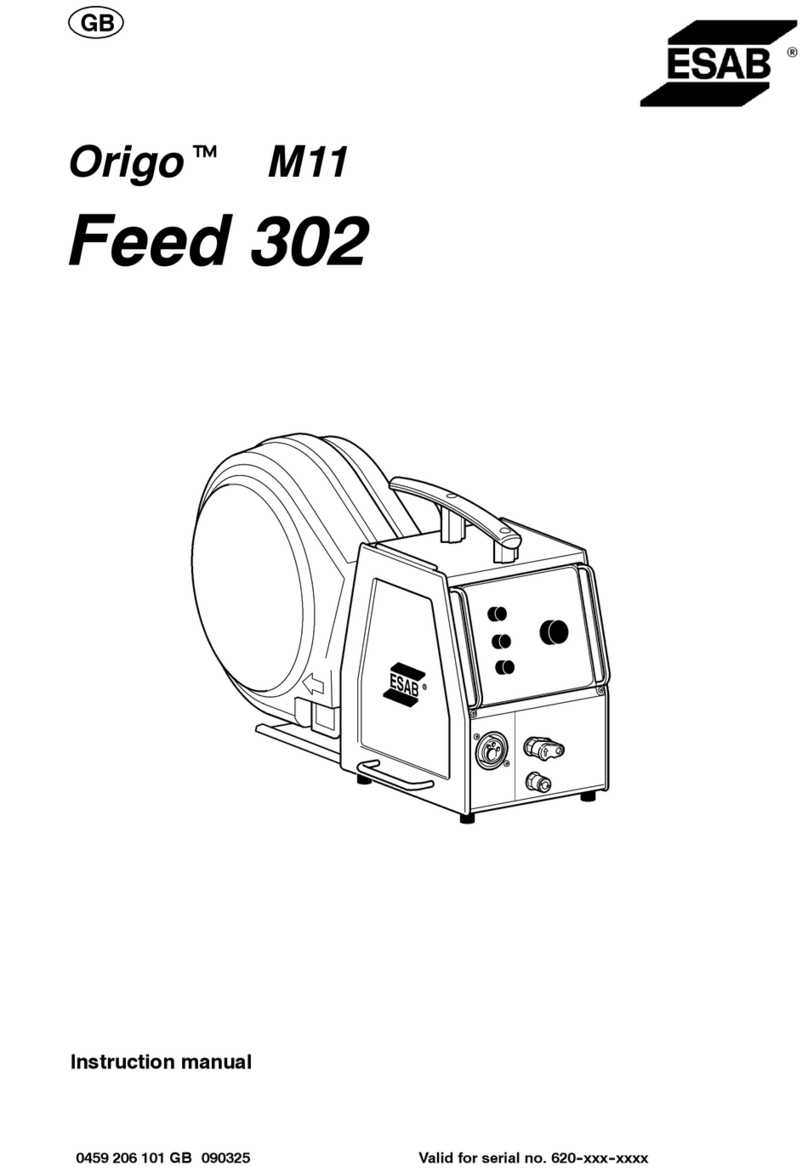
ESAB
ESAB Origo M11 Feed 302 instruction manual
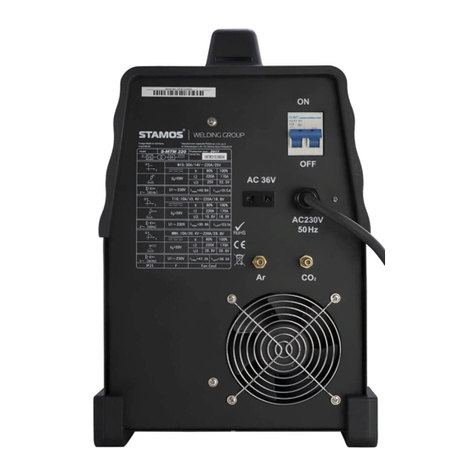
STAMOS
STAMOS S-MTM 220 user manual

Lincoln Electric
Lincoln Electric AIR VANTAGE IM10041 Operator's manual
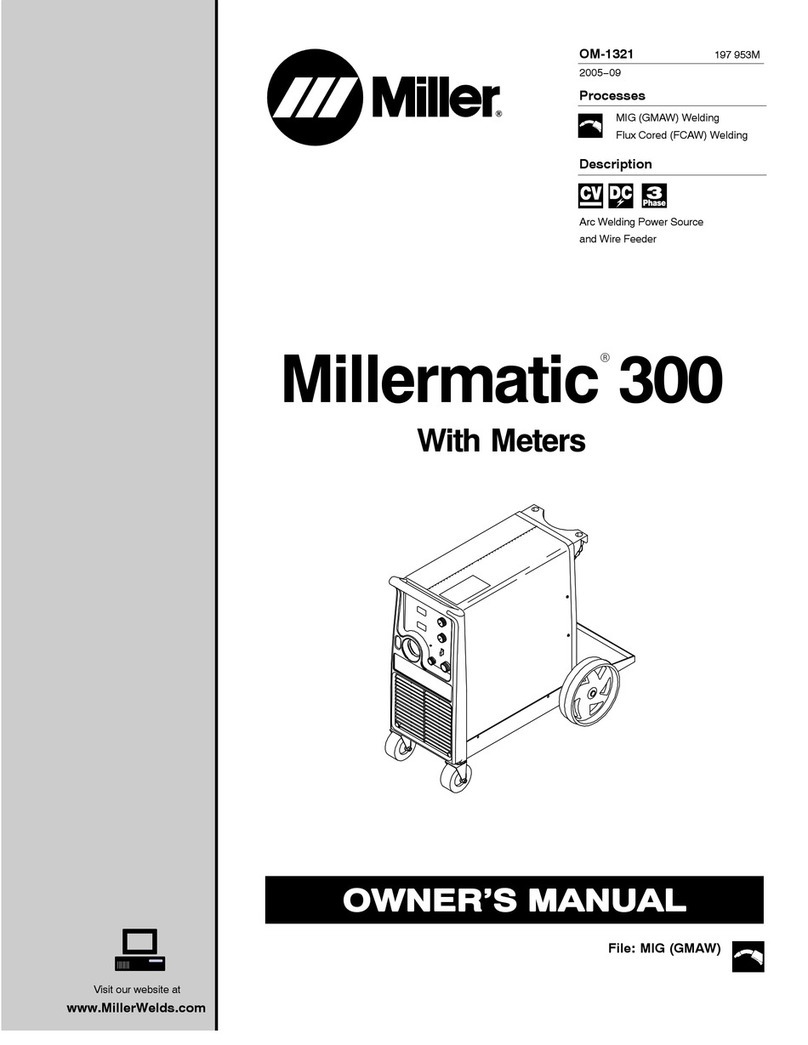
Miller
Miller Axcess 300 owner's manual
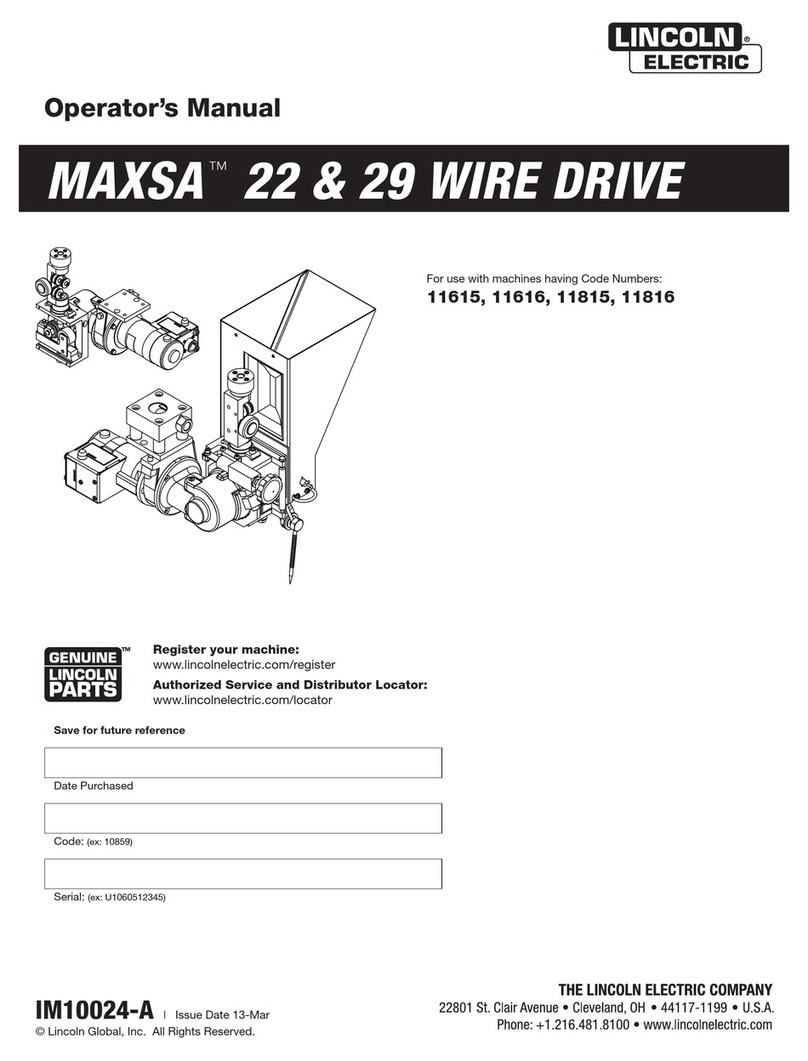
Lincoln Electric
Lincoln Electric MAXsa 22 Operator's manual

Lincoln Electric
Lincoln Electric SAE-400 SEVERE DUTY IM727 Operator's manual

Bestarc
Bestarc BTC500 manual
